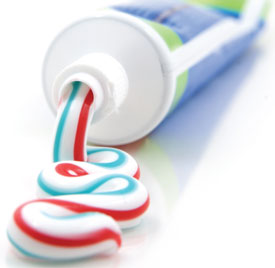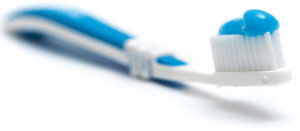Choosing toothpaste
by Bradley D. Johnson, D.D.S., M.S.D.
This article was originally published in August 2012

There are bad, nasty bugs living in your mouth that can cause diseases of the teeth and gums. They even can destroy your teeth and the supporting tissues and bone.
Many of these bacteria (collectively called plaque) produce a sticky, sugary compound that, 1) is a food storage for the bugs, 2) acts as an adhesive securing the bacteria to the teeth, and 3) insulates the bacteria from chemical and indirect mechanical insult, such as shielding the plaque from mouth rinses.
It is because of this tenacious adherence of the bacteria that the most effective means of removing them from their sticky homes involves mechanical disruption — i.e., brushing.
Removing the bacteria requires mechanical action of toothbrush bristles. Whether manual or electronic, or from pulsed acoustic energy or water, bristle disruption of the bacterial mass is the basis for tooth cleaning. This is where toothpaste bows in.
A toothpaste, in its most basic form, provides abrasives to amplify the cleansing power of the toothbrush bristles to dislodge the adherent plaque. Other additives may offer further cleaning or disease preventive benefits.
Abrasives
Abrasives added to toothpaste increase the cleansing power of the bristles’ mechanical action. They help remove plaque and superficial stains.
Toothpastes may incorporate various forms of silicates, such as insoluble aluminum or magnesium compounds, or mica, which add to the polishing potential of the toothpaste. The more “natural” toothpastes may use other polishing compounds, such as calcium carbonate (chalk), sodium bicarbonate (baking soda), and/or sodium chloride (table salt).
The more abrasive the cleaner, the greater the risk for unwanted effects. Particularly abrasive compounds, such as table salt, if used frequently and aggressively, may contribute to gum recession through abrasion of thin gum tissues. “Notching” of the softer root surfaces also may occur with use of more abrasive compounds. This notching can produce irregular surfaces that are more difficult to keep clean.
Toothpastes marketed for removing smokers’ stain tend to be of a more abrasive nature. Generally, however, abrasives in most toothpastes are not as likely to be responsible for gum recession or tooth abrasion as harder-bristle toothbrushes, or improper or overzealous brushing techniques.
Whiteners
Abrasives can be considered whitening additives because they remove surface stains and function as the primary whiteners in toothpaste. Peroxide whiteners also sometimes are added for bleaching potential. There are some questions about the safety of routine use of peroxides for whitening teeth.
Products specifically intended for whitening — from over-the-counter kits (e.g., Crest White Strips) to more powerful systems employing custom trays and gels provided by your dentist — both rely on peroxide bleaching. Bleaching of this sort removes organic color components from the enamel. While long-term effects have yet to be determined, judicious periodic bleaching does not appear to have significant negative effects. Bleaching too frequently, or bleaching to achieve a color not found in nature for teeth (“urinal white”), results in an enamel surface that picks up stain more readily. In short, the more you bleach, the more you have to bleach to maintain the color.
The most prudent approach to minimizing the impact of stain on teeth is to avoid or limit the ingestion of food and drink that contribute to staining. Saliva contains proteins that are deposited on the enamel within 30 minutes after the teeth have been polished. This protein coating has an affinity for deeply colored food and drink and picks up colors from coffee, tea, red wine and other intensely colored foods.
The most rational approach to limiting dental stain is to limit deeply colored food intake and use a toothpaste that does not contain heavy-duty abrasives. If this is not enough, a mild peroxide formulation from your dentist or over-the-counter used at specific intervals would be an acceptable approach.
Surfactants/detergents
Surfactants, or detergents, are added to toothpastes to increase foaming and cleansing power. Most commercial toothpastes use sodium laurel sulfate (SLS), a fairly harsh detergent. Certain people are sensitive to SLS and some may develop stomatitis (oral mucosal inflammation) in response to exposure. The only toothpastes at PCC with this ingredient are Tom’s of Maine (except those labeled Clean and Gentle) and one of the Auromere pastes. All other toothpaste brands at PCC are SLS-free.
Fluorides
Regardless of your opinion about ingesting fluoride through public tap water, use of fluoride in toothpaste as a topical treatment is effective in helping to prevent tooth decay. Ingesting fluorides, as in water, by individuals with mature adult teeth is not the best method for controlling dental decay.
In fact, toothpaste manufacturers caution against swallowing toothpaste with fluoride due to its toxicity. It’s advisable to use a pea-sized amount of toothpaste when brushing rather than loading the bristles the entire length of the brush as seen on commercials. Keeping fluoride toothpastes, particularly prescription-strength formulations, away from youngsters until they’ve learned how to dispense the correct amount and not eat the toothpaste is a good idea (about age 6-7).
Fluoride compounds found in toothpastes are sodium fluoride, stannous fluoride, and sodium monofluorophosphate. Of these, stannous fluoride seems to demonstrate the most potent decay-fighting potential as well as having some antibacterial properties. Most toothpastes contain about 1,000 parts per million (ppm) fluoride. Prescription forms of toothpaste for individuals with significant history of dental decay due to dry mouth or other conditions may have a concentration of 5,000 ppm.
Some recent developments in toothpastes help reverse early decay in teeth with minerals, such as calcium phosphate, to work with fluoride in rebuilding enamel. Eco-Dent dental powder at PCC, though it does not contain fluoride, does have dicalcium phosphate.

Antibacterial agents
Triclosan, classed as a pesticide, is an antibacterial agent found in some toothpastes, as well as antiperspirants and cosmetics. It has been linked to metabolic and hormonal irregularities, has been noted to degrade into a potent carcinogen, and is persistent in the environment. No personal care products at PCC, including toothpastes, contain this ingredient.
Some toothpastes at PCC have antibacterial properties because they include certain botanical extracts, such as the essential oils thymol, eucalyptol, menthol, methyl salicylate and tea tree oil. Zinc citrate also has been found to reduce plaque and tartar formation.
Xylitol, besides being a sweetening agent, has been shown to have some anti-cavity potential but only in high concentrations that would entail an extended regimen of pastes, rinses, mints and gum.
Tartar and plaque control
Tartar is calcified bacterial plaque and can be controlled in two ways. The best method is regular flossing (daily) and brushing (at least twice a day) to reduce plaque buildup. The lazier way is with chemical additives (pyrophosphates) in toothpastes that foster precipitation of salivary minerals before they can cause calcification of bacterial plaque.
In simple terms, anti-plaque and tartar-control agents work by demineralizing saliva. The downside is that this may have negative effects on dental health.
The loss of the minerals in saliva means there are lower concentrations available to remineralize the enamel, which is in a constant state of flux. A reduction in salivary minerals means more early and progressive decay. Loss of salivary minerals with use of tartar-control toothpastes also can lead to sensitive teeth in areas of exposed root surfaces.
Flavoring agents
Many toothpastes are flavored with some variation on a mint theme. Now popular are flavors such as Cool Mint, Fresh Mint, Winter Mint, and even Vanilla Mint. In toothpastes at PCC, these flavors may be derived from botanical oils or extracts. Most other toothpaste brands use synthetic flavors.
It’s interesting that many cases of oral tissue irritation can be traced to a toothpaste with intense flavoring agents. Cinnamon flavoring agents in pastes, gums and mints are particularly troublesome, sometimes even provoking oral tissue changes indicative of irritation.
Other ingredients
Often found in toothpastes are ingredients that preserve the moisture content of the product and promote “mouthfeel.” Glycerin and sorbitol are used most often, but they can be deceptive because a slippery smooth, glycerin-coated surface does not necessarily mean a clean surface.
Several toothpastes at PCC, including Burt’s Bees, Tom’s of Maine, and XClear, contain titanium dioxide, a colorant used to make pastes white and opaque. It is not in gels.
Preliminary evidence suggests that application of the enzyme CoQ10 (found in some toothpastes at PCC) may aid treatment of periodontitis. More research and evidence is needed before a firm conclusion can be drawn.
Which toothpaste is best for me?
Both major dental diseases, dental decay and periodontal disease, are caused by bacteria. Consistent brushing using an appropriate technique is the first line of defense against both.
Work with your dentist and hygienist on developing your brushing skills — remember, you don’t play Mozart the first time you pick up a violin. The same is true of your toothbrush. Effective oral hygiene for your particular situation requires education and effort.
If decay is a significant problem for you, your choice should include a toothpaste containing fluoride. Abrasives can amplify the cleaning ability of toothpaste, but be careful if you have tooth root sensitivity or gum sensitivity because both can be exacerbated by aggressive abrasives or techniques.
Pastes designed for whitening the teeth by abrasive or chemical means can have the effect of increasing root sensitivity.
Tartar control pastes that include pyrophosphates can reduce the saliva’s potential for remineralizing and protecting against early decay lesions. These tartar-control pastes also can exacerbate root sensitivity.
Becoming familiar with the ingredients of products we consume allows us to make an informed decision regarding our purchases. Something as seemingly simple as choosing a toothpaste puts us in charge of our health care choices.
Dr. Johnson is a former faculty member at the University of Washington. He’s also a consultant in the dental insurance industry and maintains a periodontal practice in Shoreline. Contact him at greatgumz@frontier.com.
